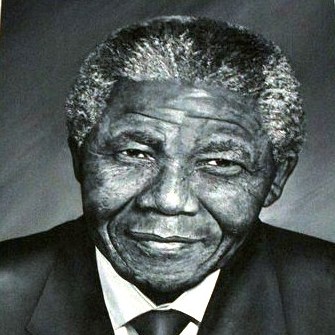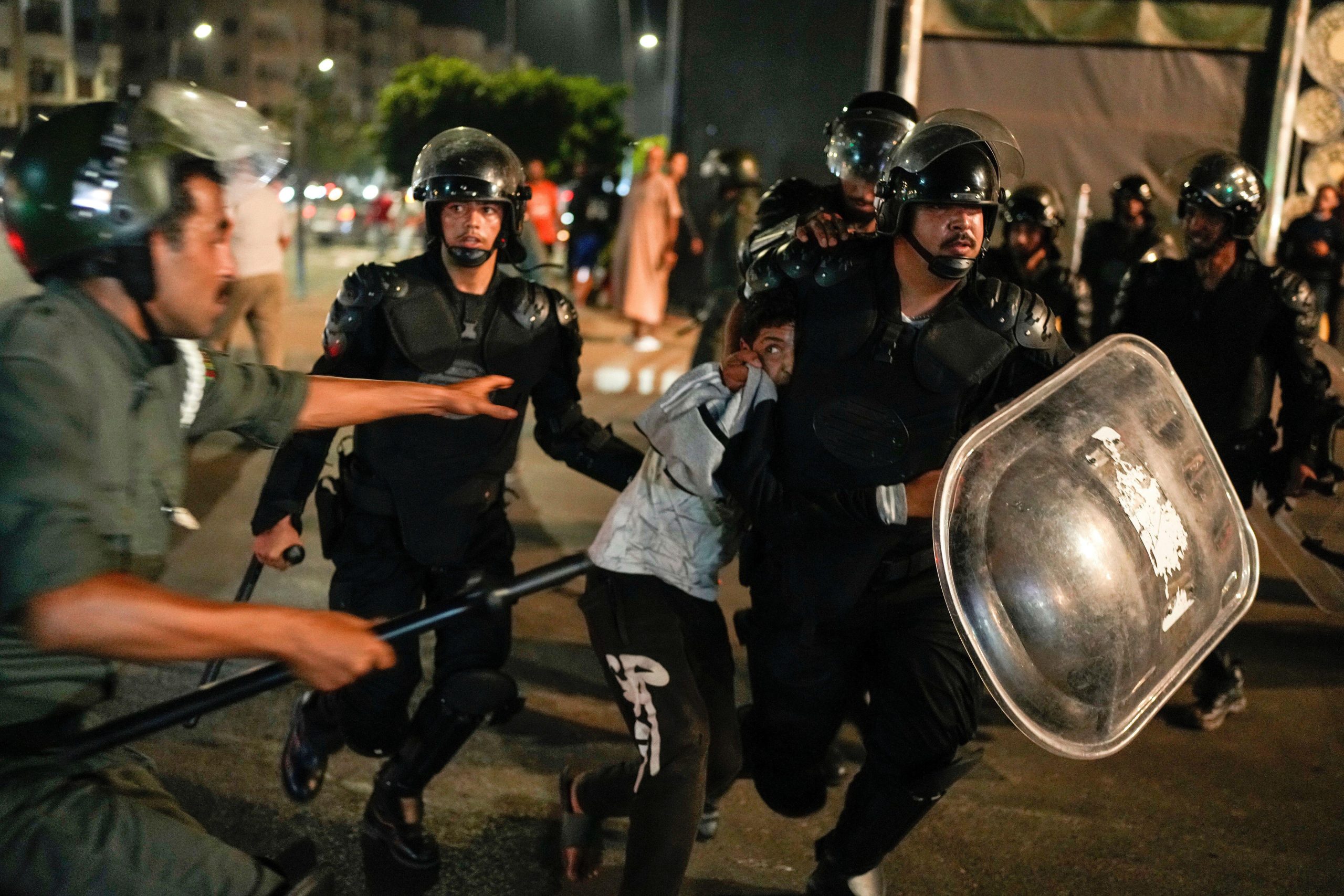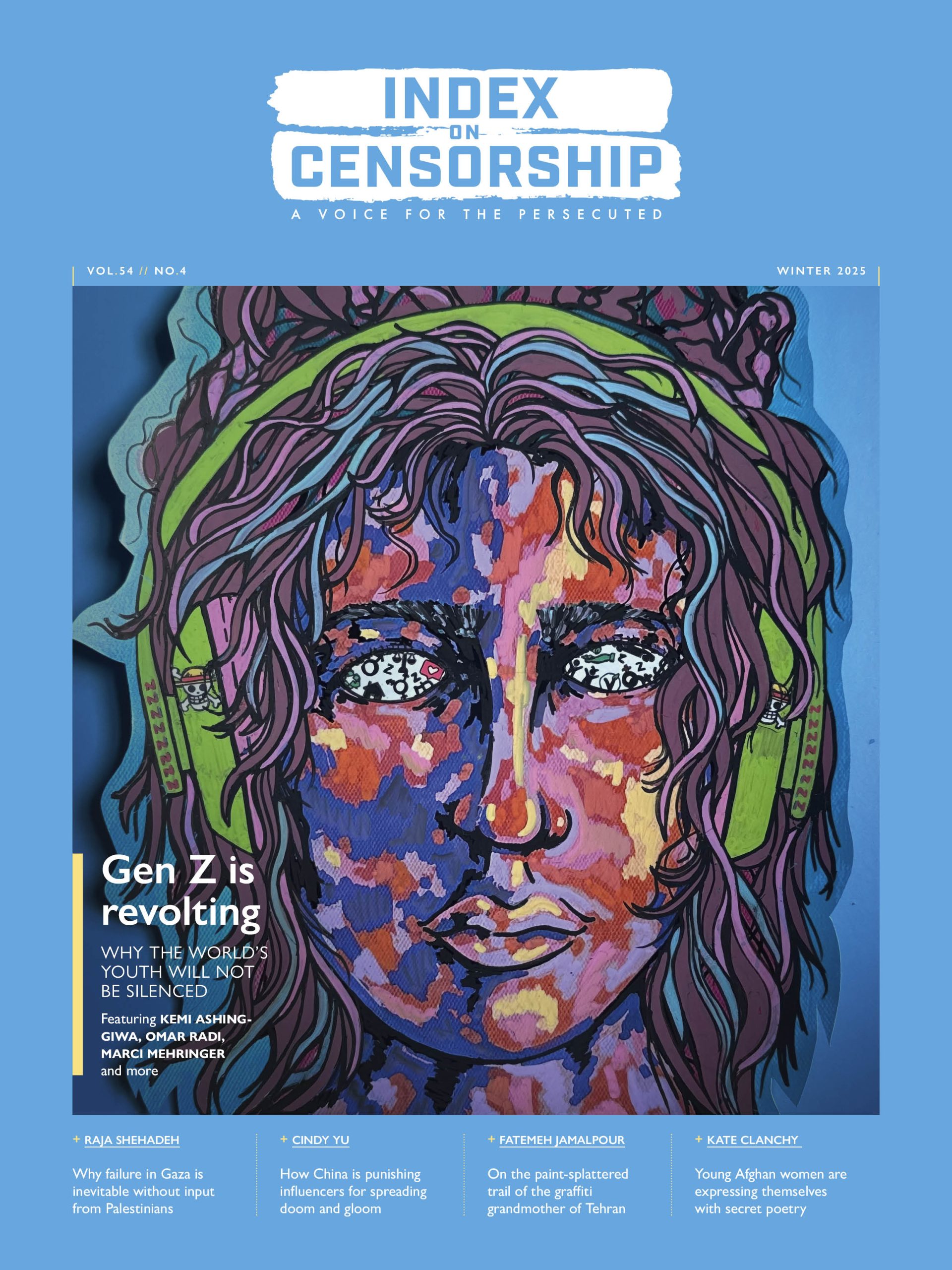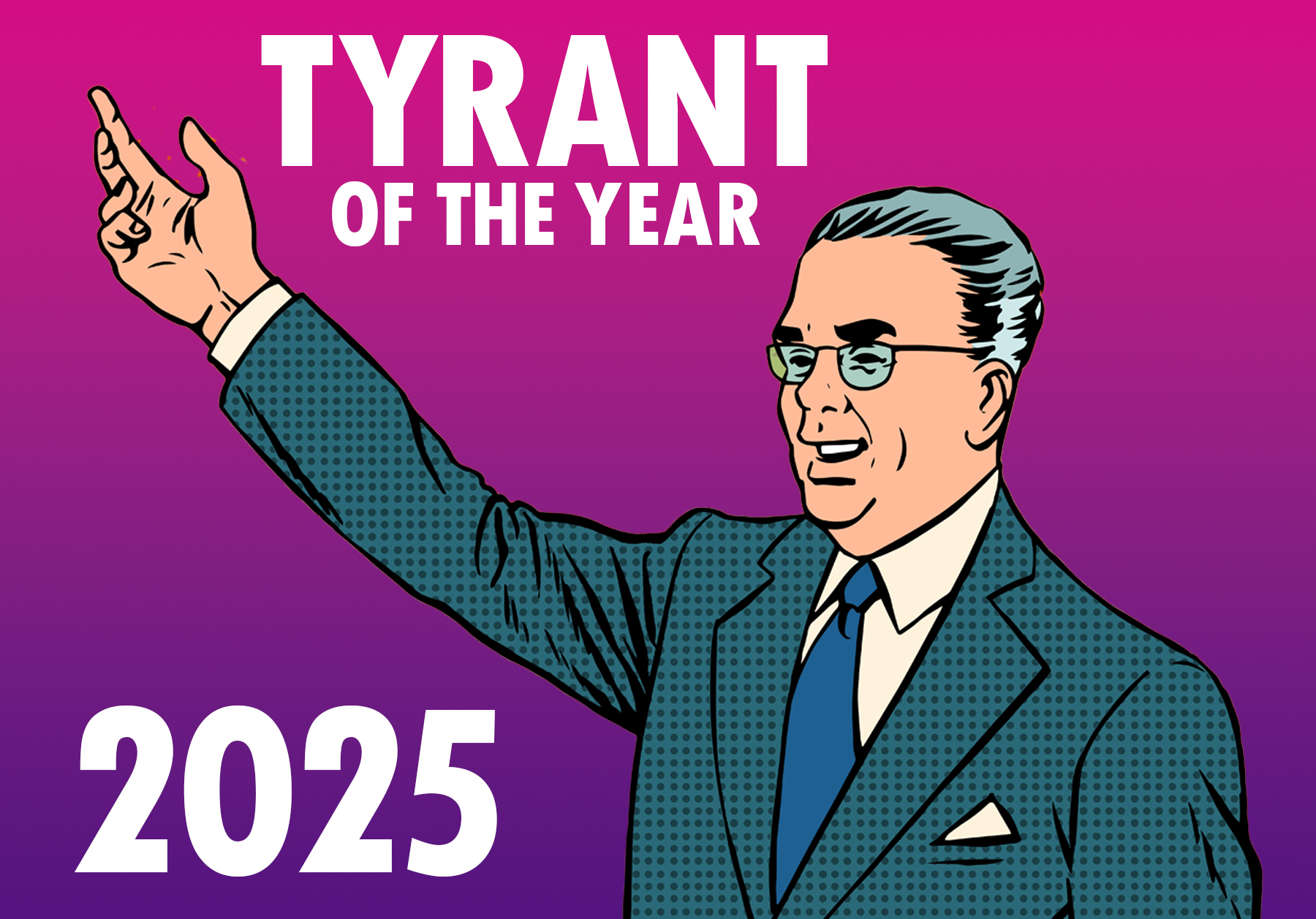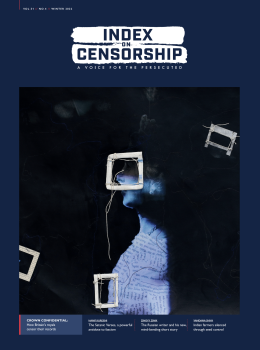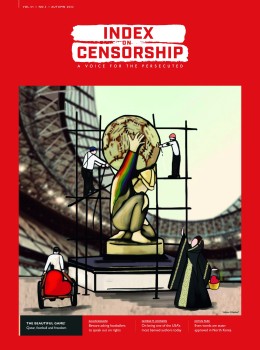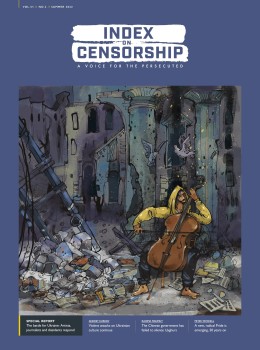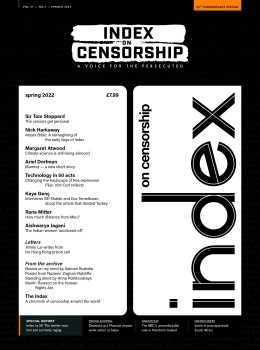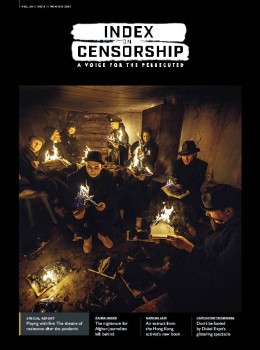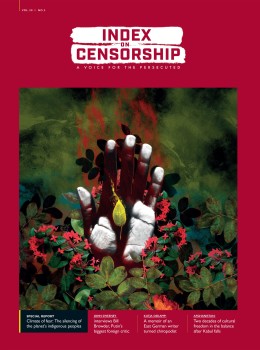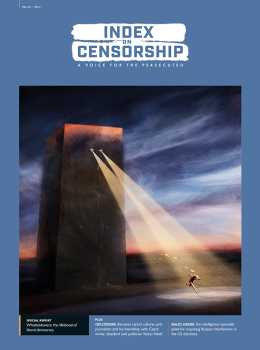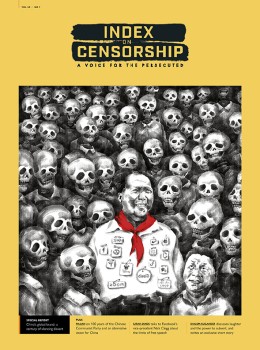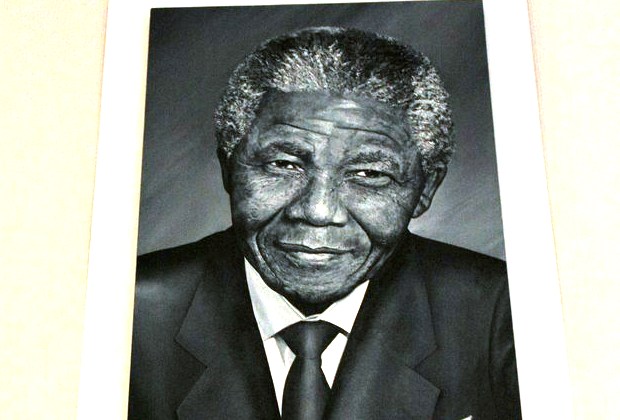
Index has released a special collection of apartheid-era articles from the Index on Censorship magazine archives to celebrate Nelson Mandela day 2016. Holly Raiborn has selected the collection, tracing the breadth of writing during the apartheid era from authors both in the country and in exile. The articles selected trace the history of this period in South Africa’s history. Significant South African writers, including Nadine Gordimer, Don Mattera, Pieter-Dirk Uys and Desmond Tutu, discuss the impacts this era of oppression had on themselves, their peers and their country. The collection will now form a reading list available to students who are researching the apartheid years, and will be available via Sage Publishing in university libraries.
Before 1948 “apartheid” was just a word in Afrikaans with a simple meaning: separateness. However, over the course of the next 50 years, the word “apartheid” would take on a new level of significance. The connotation of the word grew darker with every dissident banned, prisoner tortured, child left uneducated and home destroyed. Apartheid is no longer just a word; it carries the history of brutality, censorship and maltreatment of South Africans. For a limited period, Index and Sage are making the collection free to non-subscribers. For those who want to study the history of censorship further, Index on Censorship magazine’s archives are held at the Bishopsgate Institute in London and are free to visit.
Nadine Gordimer, Apartheid and “The Primary Homeland”
1972; vol. 1, 3-4: pp. 25-29
An address regarding the 1972 plans of the South African government to abolish the right of appeal against decisions brought by the State Publications Control Board, effectively ridding writers of a means to combat the rulings of government-appointed censors. The censorship in South Africa at this time caused a breakdown in communication between “the sections of a people carved up into categories of colour and language.”
Frene Ginwala, The press in South Africa
1973; vol. 2, 3: pp. 27-43
An extensive report on the state of the “free” press in South Africa prepared for the United Nations’ Unit on Apartheid in November 1972. Ginwala posits that apartheid attempts to segregate freedom and this attempt “extinguishes freedom itself”.
Robert Royston, A tiny, unheard voice: The writer in South Africa
1973; vol. 2, 4: pp. 85-88
A personal narrative reflecting the experiences of Robert Royston as a black poet in South Africa during a period of popularity for black poetry amongst white readers. Royston describes a disconnect between the language he speaks and the language understood by the government and white citizens, although they technically share the same tongue.
Jack Slater, South African Boycott: Helping to enforce apartheid?
1975; vol. 4, 4: pp. 32-34
An article by a New York Sunday Times staff writer arguing that the proposed cultural boycott would ultimately negatively affect black South Africans more than white South Africans who were merely irritated. Slater feared black South Africans suffer from feelings of isolation from the outside world because of the cultural boycott.
Benjamin Pogrund, The South African press
1976; vol. 5, 3: pp. 10-16
A discussion regarding the often contradictory aspects of the South African “free” press in which newspapers censor themselves. Strict laws preventing communism, sabotage and terrorism were often twisted to prevent the publications of black viewpoints.
John Laurence, Censorship by skin colour
1977; vol. 6, 2: pp. 40-43
In the UK in the 1970s, news about South Africa was contributed by the white minority while black South Africans were not interviewed by major European news outlets about events predominantly affecting their community such as the Soweto riots. This article discusses the clear racial bias, blaming it for the misinformation and misconceptions in Europe about apartheid-era South Africa.
Brief reports: Bad days in Bedlam
1978; vol. 7, 1: pp. 52-54
A report regarding the glaring health violations within the overwhelmingly black South African mental hospitals that were largely ignored due to racial factors and censorship brought about with the 1959 Prisons Act. This act made reporting “false information” on prisons or prisoners punishable with jail time or fines which led to prison and mental patient camp, conditions being largely neglected in the media.
Robert Birley, End of the road for “Bandwagon”
1978; vol. 7, 2: pp. 6-8
An article about a significant yet short-lived South African journal, Bandwagon, whose purpose was to unite individuals banned under the Suppression of Communism Act. The act featured strictly enforced limits on social life and essentially made any meetings, social or otherwise, illegal for a banned person; therefore, the impact and importance of this publication should not be understated.
William A. Hachten, Black journalists under apartheid
1979; vol. 8, 3: pp. 43-48
Hachten discusses the new found power of being a black journalist (the literacy rate of black South Africans had recently surpassed whites) and the growing hazards of the profession in the late 1970s. Journalists were arrested for reporting the events of the Soweto riots and faced constant police and legislative pressure on top of fines and censorship imposed by the white-controlled newspapers they had no choice but to work for.
Don Mattera, Open Letter to South African whites
1980; vol. 9, 1: pp. 49-50
An address from a banned poet who pointed out the cruelty of white South African society so that they may never claim ignorance to the atrocities. He questions why his words are deemed so dangerous that he is not allowed to attend social gatherings like birthdays and funerals
Nadine Gordimer, The South African censor: No change
1981; vol. 10, 1: pp 4-9
Gordimer hypothesised that the successful appeal of her novel’s banning, and that of many novels by other white writers, was due to the fact that she is white. She argued that South Africa would never be rid of censorship until it was rid of apartheid.
Donald Woods, South Africa: Black editors out
1981; vol. 10, 3: pp. 32-34
Woods wrote about the shift from editors of South African newspapers facing fines for disobeying censorship statutes to jail time in the late 1970s and explained that this shift signalled that dissent and bold writing was permitted in white politics but would not be permitted from black perspectives. He argued that the reason the government did not censor the press entirely was because they enjoyed the façade of a “free press” and there was no reason for them to need full censorship.
Keyan Tomaselli, Siege mentality: A view of film censorship
1981; vol. 10, 4: pp. 35-37
Tomaseli explained that censorship was often as financially driven as it is culturally. He wrote that censorship interferes at three stages, namely during: finance, distribution and through state censorship law. Tomaseli expands on the circumstances that led to many different films being banned or harshly edited.
Mbulelo Vizikhungo Mzamane, No place for the African: South Africa’s education system, meant to bolster apartheid, may destroy it
1981; vol. 10, 5: pp. 7-9
Mzamane claimed that the Bantu Education Act of 1956 was clearly a ploy to create compliant Africans within a society increasingly controlled by Afrikaners. Bantu schools were essentially vocational training for servitude to whites and textbooks were blatant indoctrination, he argued.
Christopher Hope, Visible Jailers: A South African writer casts a humorous eye over the bannings by his country’s censors between 1979 and 1981
1982; vol. 11, 4: pp. 8-10
A clever take on the South African censor. Hope addresses the reasons and methodology of the South African censor with tongue and cheek commentary as he reviews the Publications Appeal Board: Digest of Decisions. This collection is comprised of the totality of decisions made by the South African Publications Appeal Board.
Sipho Sepamla, The price of being a writer
1982; vol. 11, 4: pp. 15-16
Sepamla writes about the struggles of continuing to write under such strict scrutiny by censors after the banning of his latest novel, A Ride on the Whirlwind. He speaks of the disenchantment experienced by any writer that has faced censorship and specifically black South African writers who faced this treatment all too often.
Barry Gilder, Finding new ways to bypass censors: How apartheid affects music in South Africa
1983; vol. 12, 1: pp. 18-22
Music was divided along race and class lines. Music was banned under the Publications Act if it was found to be unsafe to the state, harmful to the relationship between members of any sections of society, blasphemous, or obscene Songs with even symbolic mention of freedom or revolution were banned.
Barney Pityana, Black theology and the struggle for liberation
1983; vol. 12, 5: pp. 29-31
Reverend Pityana wrote of the paradox that Christianity teaches that all are equal under god but the church in South Africa still degraded and segregated. He writes that The Bible teaches that all are created in God’s image and the plight of the Jews and other marginalised groups within the Bible give hope, guidance and reassurance to those suffering under apartheid.
Miriam Tlali, Remove the chains: South African censorship and the black writer
1984; vol. 13, 6: pp. 22-26
Tlali, a black female South African novelist, addresses the added difficulties of being black and a woman in Afrikaner-controlled society. She speaks both from personal experience and about the struggles of her peers.
Johannes Rantete, The third day of September
1985; vol. 14, 3: pp. 37-42
An honest first-hand account of the Soweto riots by a 20-year-old unemployed black South African. Rantete wrote a sympathetic eyewitness report of the September riot and the first reaction of the South African authorities to confiscate and ban it.
Alan Paton, The intimidators
1986; vol. 15, 1: pp. 6-7
The white South African novelist on the intimidation tactics and stalking committed by the security police after his controversial novel, Cry, The Beloved Country, was published. He notes that he suspects his treatment would have been even worse had he been black.
Anthony Hazlitt Heard, How I was fired
1987; vol. 16, 10: pp. 9-12
Former editor of the Cape Times, who was awarded the International Federation of Newspaper Publishers’ Golden Pen of Freedom in 1986, Heard was dismissed from his position after his interview with banned leader of the African National Congress Oliver Tambo. Heard speaks about 16 years of editing under apartheid and the circumstances surrounding his dismissal in August 1987.
Anton Harber, Even bigger scissors
1987; vol. 16, 10: pp. 13-14
‘The importance of international pressure in giving a measure of protection to the South African press cannot be overestimated’ wrote the co-editor of the Johannesburg Weekly Mail in this assessment of Botha’s policy towards the alternative press. Harber offered a compelling plea for protection of the South African alternative press by the international media.
Jo-Anne Collinge, Herbert Mabuza, Glenn Moss and David Niddrie, What the papers don’t say
1988; vol. 17, 3: pp. 27-36
An extensive review of restrictions in South Africa at that time including the Defence Act, Police Act, Prisons Act, Internal Security Act and the Publications Act. The writers offer suggestions for the safety and protection of journalists in the future.
Richard Rive, How the racial situation affects my work
1988; vol. 17, 5: pp 97-98, 103
Rive discusses the racial factors that have contributed to his writing style and the works of any black writer in South Africa. He emphasises the hypocrisy of the society he lives in which will criticise black writers as simplistic but not allow quality education and where the books of black writers sitting in libraries that they are not allowed to enter.
Albie Sachs, The gentle revenge at the end of apartheid
1990; vol. 19, 4: pp. 3-8
Albie Sachs was asked by Index on Censorship to look ahead to constitutional reform that was not foreseeable at that point and how to enshrine freedom of expression in a post-apartheid South Africa. Four months later came the unbanning of the ANC on 2 February, the release of Nelson Mandela on 11 February and his reunion with Oliver Tambo in Sweden on 12 March, all of which promised real change. These are extracts from the conversation about a future South Africa. He offers suggestions for the then-looming transition from apartheid to democracy.
Oliver Tambo, We will be in Pretoria soon
1990; vol. 19, 4: pp. 7
In May 1986 Oliver Tambo, president of the African National Congress, was interviewed by Andrew Graham. The ANC president discussed the beginning of the end for apartheid and traces the lineage of the racism that fuelled the apartheid for nearly 50 years. Tambo optimistically plans for a new reign of government made up of representation that actually reflects the populous.
Nadine Gordimer, Censorship and its aftermath
1990; vol. 19, 7: pp. 14-16
On 11 July 1979, Nadine Gordimer’s novel Burger’s Daughter was banned by the South African directorate of publications on the grounds – among others – that the book was a threat to state security. After an international outcry the director of publications appealed against the decision of his own censorship committee to the publications’ appeal board. In this article, Nadine Gordimer reflects on these events, and on the new censorship policy they heralded. Gordimer reflects on censorship under previous administrations and what she expects from President FW de Klerk’s reign as president.
Nadine Gordimer, Act two: one year later
1995; vol. 24, 3: pp. 114-117
A reflection on how far South Africa had come and still had to go by this frequently banned author. Using the Descartes method, Gordimer considers the role reversal that has occurred in post-apartheid South Africa as her once banned colleagues ascend to political power.
Desmond Tutu, Healing a nation
1996; vol. 25, 5: pp. 38-43
An Index interview with Archbishop Desmond Tutu, Tutu discusses the urgency of healing the past before South Africa can truly move on to a brighter future. This brighter future was to be achieved with the aid of the Truth Commission. He argued that only honesty, compassion and forgiveness would lead to national unity in South Africa, even if that means prosecuting former ANC members. He stresses that the commission’s goal is reparations and not compensation.
Pieter-Dirk Uys, The truth, the whole truth, and nothing but…
1996; v0l. 25, 5: pp. 46-47
Famed satirist Pieter-Dirk Uys questioned if information about the atrocities of the apartheid could actually be uncovered by the Truth Commission. Uys asked how the country could heal when so many willing participants in the apartheid already seemed eager to forget or to forge their own accounts of history to avoid blame. His pessimistic view contrasted with that of Archbishop Desmond Tutu’s.
All articles from Index on Censorship magazine, from 1972 to 2016, are available via Sage in most university libraries. More information about subscribing to the magazine in print or digitally here.

